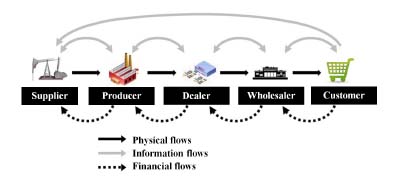8Supply Chain Management
So far, we have studied logistic problems separately. We were able to show the difficulties of each, mostly due to their algorithmic complexity, and stress the importance of metaheuristics to solve them. Throughout this chapter, dedicated to supply chain management, we will find that all these problems are related, linked by a “horizontal synchronization”, with an effort of coordination by the different actors and/or the different activities present in the supply chain, and linked also by a vertical synchronization, so that decisions taken at any given level (strategic, tactical or operational) are consistent with decisions taken at other levels.
8.1. Introduction to supply chain management
[GAN 95] defines the supply chain as follows: “A supply chain is a network of facilities and distribution options that performs the functions of procurement of materials, transformation of these materials into intermediate and finished products, and the distribution of these finished products to customers”. Figure 8.1 shows a classic supply chain with the actors that intervene and different flow types that go through it (physical, information or financial).
To the activities of purchasing, production and distribution that appear in this definition, we can also add activities for stocking finished products, as well as raw materials and semi-finished products.

Get Metaheuristics for Logistics now with the O’Reilly learning platform.
O’Reilly members experience books, live events, courses curated by job role, and more from O’Reilly and nearly 200 top publishers.

